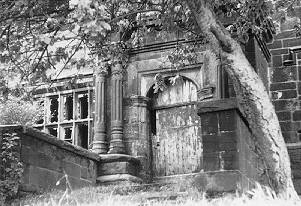Clegg Hall

If you are driving towards Milnrow from the Smithy Bridge side, take a right off Wildhouse Lane onto Branch Road. Go as far as you can go and there by the canal, is Clegg Hall. The large Grade 2 listed building stands on the site of a much older building thought to have been occupied in an area known as Little or Great Clegg which gave the hall its name although no Clegg families having ever lived there. The original hall was built by Theophilus Ashton, a lawyer and one of the Ashtons of Little Clegg at some time between 1610 and 1618. It was described in a 1626 survey of Rochdale halls and buildings as “a faire capital messuage (an old term for dwelling house with land and outbuildings) built with free stone with all new fair houses of office there-unto belonging with gardens, fishponds and divers closes of land”. In the same record there was also mention of barns, stables, courts, orchards, gardens, folds and pigeon houses. All are agreed about its grand stature with its 2 storeys, its bay windows and an imposing entrance porch and portico.

The occupancy of Clegg Hall was not always domestic. By the late 19th century it was used as a country alehouse or inn with local working people lodging in its rooms. A Charles Turner owned the hall in the 18th century and at that time it was the Hare and Hounds although better known locally as Black Sloven after Turner’s favourite horse. Subsequent owners were John Entwistle of Foxholes (and of Entwistle Road fame) and the Fenton family from Crimble who operated flannel factories adjacent to the hall. Water from Hollingworth Lake powered Fenton’s Clegg Hall Mill which stood close to the canal. Weavers cottages nearby housed some of his workforce. In the 19th century James Tweedale had a cotton mill on the same site and in 1879 Thomas Wilson bought the mill to spin cotton waste. By the 19th century, Clegg Hall itself had reverted to a domestic dwelling from its role as public house when the license was removed because the building was becoming too dilapidated to continue trading in beer and ales. Later inhabitants included one Sam Gartside who was born at Clegg Hall and lived there in what must have been some squalor from 1917 until 1939.

Best known about Clegg Hall is its haunting. The earliest accounts of the Boggart of Clegg Hall appear in the early 20th century in Reverend Oakley’s ‘In Olden Days’ and concern the murder in the original hall in the 13th century of two nephews (although some say a niece and a nephew) by Richard, the brother of Henry de Clegg, the master of the house who was away fighting in one of the Crusades. On his return, the wicked brother looked to kill the father too so that he could secure the hall for himself whereupon one of the dead boys could be heard calling ‘Father beware !’ which woke him up. Some versions claim that the waking Henry then killed his wicked brother. Since that day, so the story goes, the boy’s ghost or boggart can be heard in Clegg Hall alerting his father to the potentially ghastly deed. An alternative version is that the boggart is the wicked uncle Richard himself, ridden with guilt and walking the corridors of the hall at night bewailing his crimes. The room where the murder of the two children was committed – known as the Boggart Chamber – was supposed to be the most haunted place in the hall and one in which no-one dared sleep ! In recent years Milnrow’s MAD Theatre Company held a ghost hunt in the hall to promote a play about the story of Henry de Clegg and the haunting which they later performed at Ellenroad Steam Mill.

As is clear from the details of the haunting story, the hall now standing was not the original. In fact, buildings on the site have been gutted by two fires, one in the early 1900’s and another in the 1950’s although regardless of the fire the house had been in poor condition for some time. In the 1920’s it was described as ‘a ruined hall’ even though, by all accounts, Sam Gartside was still living there ! After World War II the hall had lost its impressive portico over the front door and much of the roof was missing too. Many people remember the ruins in the 1950’s as still having the upper floors more or less intact although rooms on the ground floor were sometimes used by a local farmer to house cattle.
In an attempt to save the hall, a heritage organisation bought Clegg Hall in the 1980’s and then later sold it on privately after which it was renovated. Restoration to its original state has continued into the 21st century, notably by Mr Jason Stead who was also in charge of restoring Healey Hall. The scale of the task of renovating Clegg Hall can be guessed by noting that at its worst, trees were growing from the inside walls and through the floorboards. However, work went ahead and currently the building has been restored to a remarkable degree, preserving it for those interested in local history and ghost hunting ! Whilst some of Rochdale great houses have gone such as Bamford Hall and Summer Castle, Clegg Hall stands as stately as ever beside the Rochdale Canal.